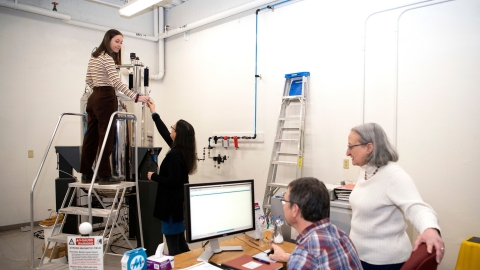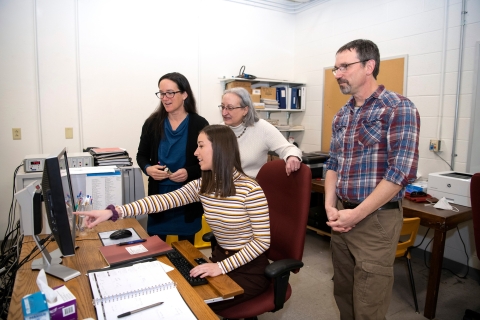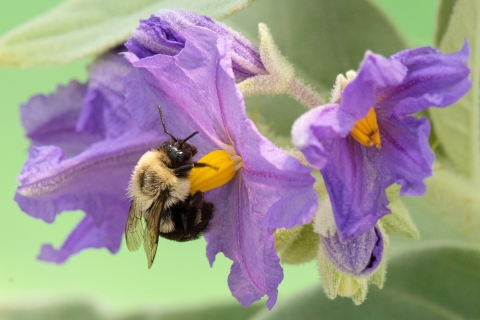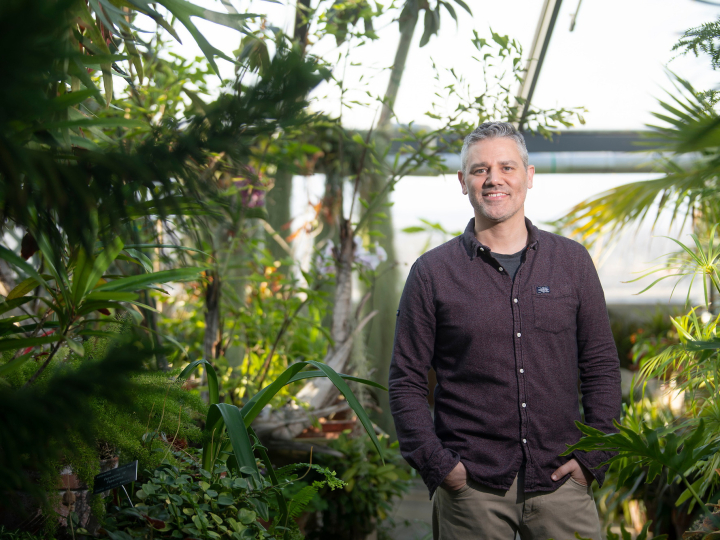
Bee Brain Research Detects Metabolic Stressors in Pollinators
April 5, 2022
Jayne McDevitt '22 reaches for a specimen from Professor Beth Capaldi while professors David Rovnyak and Marie Pizzorno review data. Photo by Emily Paine, Communications
The bees are back in town. Many of the bee species in Pennsylvania emerge between March and April and are critical for pollination of native plants and tree fruit crops. But U.S. beekeepers reported losing 45.5% of their managed honeybee colonies from April 2020 to the following spring, according to results of the national survey by the nonprofit Bee Informed Partnership. There are fewer bees, and North American pollinators in general, than there used to be for a number of possible reasons.
A team of Bucknell University researchers is now attempting to unravel the complex factors impacting the health and behavior of honeybees and native pollinators with a novel approach. They're getting inside the bees' heads, or, rather, their brains. The researchers are using nuclear magnetic resonance (NMR) spectroscopy to measure metabolic markers of changes in the bee brain caused by stress, which has been implicated in colony collapse disorder.
The three Bucknell science faculty members and six students who are part of the research team have already published two papers on their work, the latest within the last three months in the journal Metabolites.

McDevitt points out her findings to the rest of the Bucknell team. Photo by Emily Paine, Communications
"There are a number of different factors such as pesticides, mites, viruses, climate change and others which have been cited as possible factors in the decline of honey bee populations," says Jayne McDevitt '22, cell biology/biochemistry major and lead author in the Metabolites study. "So through our research we work to better understand the effects of these factors by uncovering metabolic differences between bees that are healthy and bees that are diseased."
The Bucknell team used the University's 600 MHz spectrometer to analyze soluble metabolites [metabolic byproducts] from bee brains, which were extracted from honeybee samples to determine the health of those bees. Their analysis is establishing baseline data to help researchers tell the difference between metabolites found in healthy bees versus those of diseased bees that show signs of stress.
"We hope to use this information to develop protocols and methodology for discovering biomarkers that might differ between healthy bees and diseased bees," McDevitt says.
The Metabolites paper complimented a study led by Professor Marie Pizzorno, biology, published last year in the journal Viruses, showing the effect viral infection has on the bee brain. It reported that protein expression in the brain was changed considerably by viral infection.
"One of the things our earlier study showed is that the brain in infected bees is really messed up," says Pizzorno, who was also a co-author on the Metabolites study. "In addition, we can see signs of viral infection in the metabolome [total number of metabolites present within an organism] because bees make antimicrobial peptides when they are sick. One of these proteins is extremely proline [an amino acid] rich."
Through a companion study of the infected bees as well as ongoing studies of several research hives at Bucknell with NMR metabolomics, the team is establishing biomarker standards that researchers and potentially even beekeepers may use in the future to better understand the health of their hives. If they can determine a hive is unhealthy, they may be able to nurse it back through diet.

A bumblebee pollinates a flower inside Bucknell's Bee Dome. Photo by Emily Paine, Communications
"Bees can selectively eat things that are good for them. For instance, they selectively choose floral resources if they need more proline," says Professor Beth Capaldi, biology and animal behavior, a bee researcher who is a co-author on both studies. "So part of the intrigue about this developing research is how bees can self-medicate through what they eat to protect themselves against a virus. Their foraging behavior may help them defend against these things [stresses]."
The Bucknell research has been a breakthrough for the assessment of bee health.
"From a technology point of view, this [metabolite biomarkers work] is a new way to measure bee health," says Professor David Rovnyak, chemistry, a co-author on both studies. "A beekeeper may be looking at 10 hives and have difficulty figuring out the different stresses they’re all experiencing. This allows us to report on what they're feeling right now. Overall, you can now gauge the health of a single bee or hive in a way we previously couldn't do."
Because of the predictability of their biomarkers, Rovnyak says beekeepers may someday be able to send away samples for testing to determine the health of their hives and treat them before they experience great losses.
The Bucknell researchers are continuing their bee metabolites work, including a collaboration with co-author Dr. Amy Freund, a senior applications scientist at Bruker BioSpin, on their latest project to develop metabolomic measurements of honeybees on emerging magnetic resonance technology.

